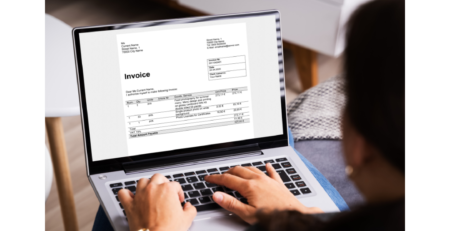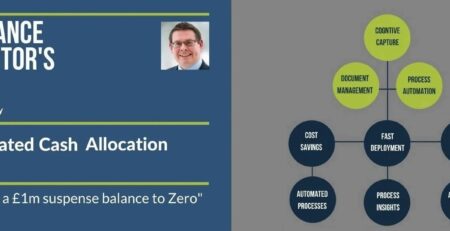Fortifying Finance: Preventing AP Fraud with Cloud-Based Accounts Payable Automation
In an increasingly digital age, safeguarding financial assets has become a paramount concern for businesses of all sizes. The realm of accounts payable, in particular, stands as a critical juncture where AP fraud can quietly infiltrate and wreak havoc.
Enter cloud-based AP automation, a technological bulwark against illicit activities. This dynamic fusion of cloud computing and automation not only streamlines the accounts payable process but also erects a formidable barrier against potential fraudsters. In this blog, we delve into the intricate web of financial security, exploring how cloud-based AP automation stands as a sentinel, actively thwarting fraudulent attempts. Join us on this journey as we uncover the tactics, strategies, and technologies that are reshaping the financial landscape, fortifying businesses against the ever-present threat of fraud.
Examples of AP Fraud in Accounts Payable
Here are some of the most common types of fraud in AP:
- Invoice Fraud
Overbilling: A supplier intentionally inflates the price on an invoice for goods or services that were provided at a lower cost.
Phantom Invoices: Fraudsters create fake invoices for goods or services that were never delivered or provided.
- Employee Fraud
Ghost Employees: A dishonest employee creates fictitious employees and submits timecards for them, then collects the pay.
Collusion: An employee conspires with a supplier to create fake invoices or approve inflated prices in exchange for kickbacks.
- Vendor Fraud
Shell Companies: A dishonest vendor sets up a fake company and bills the organisation for goods or services that were never provided.
Kickbacks or Bribes: Vendors may offer or provide kickbacks or bribes to employees in exchange for preferential treatment.
- Duplicate Payments
Accidental Duplicate Payments: Due to errors or system glitches, a company might unintentionally pay the same invoice twice.
- Misappropriation of Funds
Misdirected Payments: An employee redirects payments meant for a legitimate vendor to their own account.
Expense Fraud: Employees submit false or inflated expense reports for personal gain.
- Phishing and Social Engineering
Impersonation: Fraudsters pose as a legitimate vendor or executive and request a change in payment details to divert funds.
- Manipulation of Financial Records
Falsifying Financial Statements: Employees or external parties alter financial records to hide fraudulent activities.
- Unauthorised Access
Unauthorised Approvals: An employee with inappropriate permissions approves invoices or payments they shouldn’t have access to.
- Redirection of Payments
Man-in-the-Middle Attacks: Hackers intercept communications and alter payment details to redirect funds to their own accounts.
- Identity Theft
Stolen Vendor Identity: A fraudster poses as a legitimate vendor and submits invoices for payment.
Real World Examples of Fraud
NatWest Payment Processor Fraud (2019):
In 2019, an employee at NatWest’s payment processing centre in Birmingham was found guilty of orchestrating a fraud scheme. The individual created fake invoices and directed payments to their personal account. The fraud amounted to approximately £200,000.
University of York (2017):
In 2017, an employee at the University of York was convicted of submitting false invoices for personal goods and services. The fraud amounted to over £300,000.
Columbia Sportswear (2019):
A former employee of Columbia Sportswear created a fictitious company and submitted fraudulent invoices for marketing services. The company paid out over $3 million before discovering the scheme.
Sungard Availability Services (2019):
In 2019, a former employee of Sungard Availability Services, a company that provides IT services, was found guilty of a fraudulent scheme. The employee created and submitted false invoices for goods and services that were never provided. The fraudulent invoices amounted to over $1.5 million.
Walmart Vendor Fraud Scheme (2019):
In 2019, Walmart filed a lawsuit against its former VP of Replenishment, alleging that he had engaged in a fraudulent scheme involving fake invoices. The individual was accused of embezzling millions of dollars over several years.
Scotiabank Heist (2020):
In 2020, a former Scotiabank employee in Canada was charged with a $30 million embezzlement scheme. The employee allegedly created fictitious companies and submitted fraudulent invoices for services that were never provided.
Krebs on Security Vendor Fraud (2020):
In 2020, security expert Brian Krebs reported an incident where a vendor’s email was compromised. The fraudsters intercepted legitimate invoices, altered the bank details, and sent them to the victim’s clients. This resulted in payments being directed to the fraudsters’ accounts.
Redbridge Council (2012):
In 2012, an employee of Redbridge Council in London was found guilty of orchestrating a fraud scheme involving fake invoices. The individual submitted false invoices for work that was never done, resulting in a loss of over £700,000 to the council.
London Borough of Croydon (2011):
A former employee of the London Borough of Croydon was convicted in 2011 for creating false invoices and diverting payments to her personal bank account. The fraud amounted to over £170,000.
Surrey County Council (2011):
In 2011, an employee of Surrey County Council was convicted for submitting fake invoices for personal goods and services. The fraud amounted to approximately £500,000.
It’s crucial for businesses to implement robust internal controls, conduct regular audits, and utilise technology like cloud-based AP automation to help prevent and detect fraudulent activities in their accounts payable processes.
How to Avoid Fraud In AP
To avoid fraud in accounts payable, businesses can implement a combination of policies, procedures, and technology solutions. Here are some key steps:
- Establish Strong Internal Controls:
- Implement segregation of duties so that no single individual has control over all aspects of the accounts payable process.
- Require dual authorisation for sensitive transactions, such as large payments or changes to vendor details.
- Vendor Verification and Due Diligence:
- Conduct thorough background checks on new vendors before establishing a business relationship.
- Confirm the legitimacy of vendors through independent sources or trusted third-party services.
- Invoice Verification and Approval Workflows:
- Set up rigorous approval workflows to ensure that invoices are reviewed and approved by the appropriate personnel before payment.
- Verify that invoices align with purchase orders, delivery receipts, and contract terms.
- Automate Invoice Processing:
- Implement cloud-based AP automation solutions that utilise advanced algorithms to detect discrepancies and fraudulent activities.
- Use Electronic Payments and Secure Platforms:
- Shift towards electronic payment methods like ACH transfers or virtual credit cards, which have built-in security measures.
- Use secure, encrypted platforms for communication and transactions.
- Monitor for Unusual Activity:
- Regularly review accounts payable reports and transaction logs for anomalies or suspicious patterns.
- Set up alerts for unusual activities, such as sudden changes in payment amounts or vendor details.
- Perform Regular Reconciliations:
- Reconcile accounts payable records with bank statements and other financial records on a regular basis to detect discrepancies or unauthorised transactions.
- Implement Strong Password Policies and Security Measures:
- Enforce strong passwords and regular password changes for all accounts payable systems and platforms.
- Use multi-factor authentication (MFA) to add an extra layer of security.
- Conduct Employee Training and Awareness Programs:
- Educate employees about common types of accounts payable fraud and how to recognise suspicious activity.
- Encourage a culture of vigilance and reporting any potential issues promptly.
- Regularly Review Vendor Contracts and Agreements:
- Ensure that vendor contracts are clear and comprehensive, specifying terms, deliverables, and payment details.
- Monitor vendor performance and address any discrepancies or concerns promptly.
- Perform Internal and External Audits:
- Conduct regular internal audits to review accounts payable processes and identify any potential weaknesses or areas for improvement.
- Engage external auditors to provide an independent assessment of accounts payable controls.
- Stay Informed About Emerging Threats:
- Keep abreast of evolving fraud tactics and cybersecurity threats to proactively adapt security measures.
By implementing these measures, businesses can significantly reduce the risk of accounts payable fraud and protect their financial assets.
AP Automation Solution Features for Reducing AP Fraud
Cloud-based accounts payable (AP) automation reduces fraud through a combination of advanced technologies, secure processes, and real-time monitoring. Here’s how it works:
Everything you need to know about automated invoice processing
Advanced Data Validation: Cloud-based AP automation employs sophisticated algorithms to automatically validate invoice data. It checks for discrepancies, duplicates, and unusual patterns, flagging potentially fraudulent invoices for further review.
Invoice Matching: The system matches incoming invoices with corresponding purchase orders and delivery receipts. This reconciliation process ensures that the goods or services were actually received before payment is approved, reducing the risk of fraudulent invoices.
Rule-Based Approval Workflows: The system allows businesses to establish custom approval workflows. These rules ensure that invoices are reviewed and approved by the appropriate personnel, minimising the chance of unauthorised payments.
Real-Time Monitoring: Cloud-based AP automation provides real-time visibility into the entire invoice processing cycle. This process intelligence allows for immediate detection and response to suspicious activities, including irregular payment amounts or unusual vendor details.
Audit Trails and Transaction Logs: A comprehensive audit trail is maintained, documenting every action taken within the system. This transparent record helps in tracing any suspicious activities back to their source, providing crucial evidence in case of fraudulent activity.
Multi-Factor Authentication (MFA): Cloud-based systems often incorporate MFA, requiring users to provide multiple forms of authentication before accessing sensitive financial data. This additional layer of security helps prevent unauthorised access.
Machine Learning and AI: Advanced machine learning algorithms can analyse historical data to identify patterns indicative of fraud. Over time, the system becomes better at distinguishing between legitimate and suspicious transactions.
Alerts and Notifications: Cloud-based AP automation can be configured to send alerts or notifications for unusual activities, such as a sudden change in payment amount or a new payee. This immediate notification allows for prompt action to prevent fraudulent payments.
Secure Access Controls: Role-based access controls ensure that only authorised personnel have access to sensitive financial information. This prevents unauthorised individuals from tampering with or approving invoices.
Encrypted Data Transmission and Storage: Data is encrypted both during transmission and while at rest on the cloud servers. This protects it from interception or unauthorised access by cybercriminals.
Regular Security Updates and Patch Management: Cloud providers are responsible for maintaining the security of their platforms. They regularly apply security patches and updates to address vulnerabilities and emerging threats.
Book a demo today to witness the seamless integration capabilities of cloud invoice processing with your existing ERP systems.
How can an AP Automation Solution Help to Reduce Fraud
With its sophisticated algorithms and real-time monitoring capabilities, cloud-based AP automation solutions introduce a new era of financial security. By automating the validation of invoices, cross-referencing them with purchase orders, and scrutinising payment details, this technology identifies irregularities that may otherwise go unnoticed.
Moreover, it establishes a comprehensive audit trail, providing a transparent record of every transaction and approval. This level of visibility not only acts as a deterrent to potential wrongdoers but also empowers businesses with the tools to swiftly detect and respond to any suspicious activity. As we delve deeper into this transformative landscape, we’ll unravel the layers of protection that cloud-based AP automation offers, enabling businesses to navigate the intricate world of finance with confidence and resilience.
Furthermore, cloud-based AP automation doesn’t just stop at detection; it proactively strengthens defences against potential threats. With advanced machine learning algorithms, it learns from patterns and anomalies, refining its ability to discern legitimate transactions from suspicious ones. Customisable alerts and notifications add an extra layer of security, ensuring that any flagged activity is promptly brought to the attention of relevant stakeholders. As businesses embrace this fortified financial infrastructure, they’re not only protecting their bottom line but also fostering an environment of trust and integrity in their financial operations.
In a landscape where financial security is paramount, the role of cloud-based AP automation cannot be overstated. By fortifying the accounts payable process with cutting-edge technology, businesses are not only minimising the risk of fraud but also revolutionising their financial operations. This innovation enables a shift from reactive measures to proactive defence, allowing organisations to stay one step ahead of potential threats.
Summary
With the use of a cloud-based AP automation platform, it’s evident that businesses are equipped with a powerful defence against fraud in the modern digital landscape. By embracing cutting-edge technology, organisations can not only streamline their accounts payable processes but also proactively thwart potential fraudulent actions.
The fusion of cloud computing, automation, and advanced security measures heralds a new era of financial resilience. With vigilant monitoring, robust internal controls, and the adoption of best practices, businesses can forge ahead with confidence, knowing their financial assets are safeguarded. Embracing cloud-based AP automation isn’t just a technological upgrade; it’s a strategic investment in the trust, integrity, and prosperity of every financial transaction.
Are you ready to unlock the potential of cloud invoice processing for your business? Take the next step by booking a demo today.
Are you ready to unlock the potential of cloud invoice processing for your business? Take the next step by booking a demo today.











